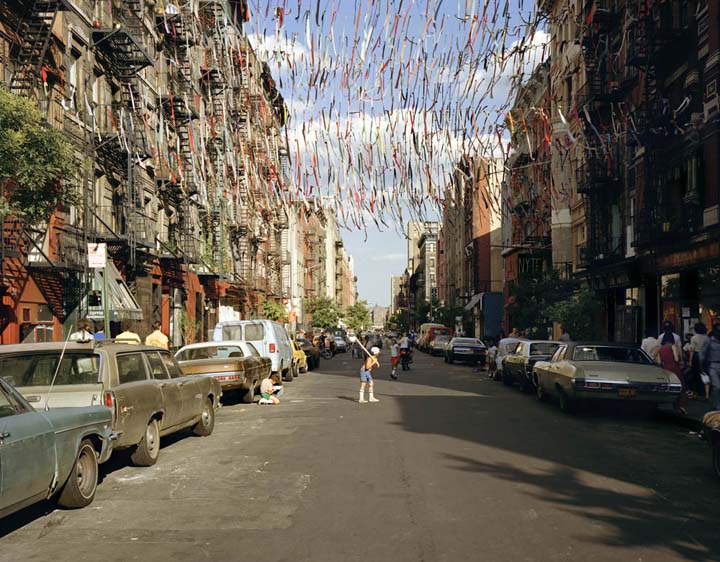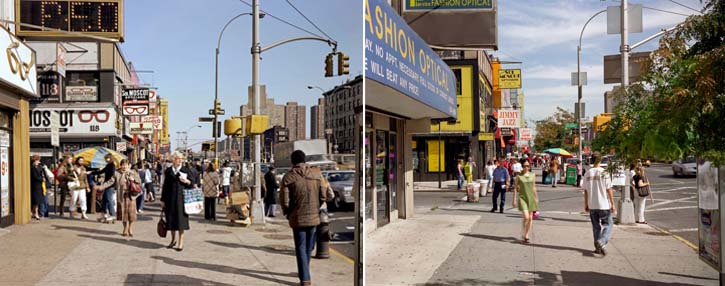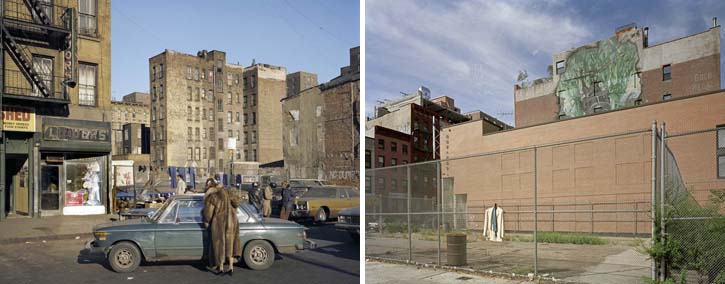Brian Rose: Time & Space on the LES

In Time and Space on the Lower East Side, 1980 + 2010, photographer Brian Rose has created an unusual portrayal of a place that, for many, spurs total recall of formative moments in their lives. As a student at Cooper Union, he had the idea, in 1979, of documenting the area using a 4 x 5 camera, following in the footsteps of Eugene Atget and Walker Evans, in Paris and Alabama, respectively. “Lacking a camera, and wary of wandering the streets alone,” he writes, “I enlisted Ed Fausty, fellow Cooper student and superb photographer, as collaborator.” On completing the project, the photographers had an exhibition at the Henry Street Settlement, then packed the work away and moved on to other projects.
Time and Space is a compilation of images the two created working together, along with a new group of photographs that Rose made 30 years later on his return after a 12-year absence from the city. The new images are not a re-photographing project [as Christopher Rauschenberg has done with Atget’s Paris], but rather another look at a place where change is a continuum along the many facets of the neighborhood’s fabric. Seen together, and sequenced in a seemingly random way, the images avoid the quaint and the dramatic. Instead they reveal the embodiment of a particular urban experience recalled as a sense of place. I emailed Brian last week to ask if he would consider writing about a selection of images from the book that had particular meaning for him. Here’s what he wrote for DART:
In 1977, when I first arrived in New York to attend Cooper Union, I found an apartment on East 4th Street between the Bowery and Second Avenue. East 4th was a world unto itself—an intensely political community galvanized by the city’s potentially destructive urban renewal plans—and home of the La Mama theater and other innovative arts groups.
I met my wife there, just to the left of where the cover photograph (above) was taken. And the block was home to Alex Harsley’s 4th Street Photo Gallery, which has been a gathering place for artists and photographers for decades. The picture means a lot to me personally, but it also epitomizes the basic structure of the Lower East Side, the wall of tenement facades and the distant vanishing point of the street formed by New York’s grid.
For a dozen years I lived in Amsterdam, and I was there on 9/11 when catastrophe struck. I returned to New York a week later, to my studio on the Lower East Side, connecting with friends and considering how I might respond to events as a photographer. Not being a photojournalist, I knew that whatever I did would have to be a slower more distanced approach. So, eventually I came to the conclusion that I should re-photograph the Lower East Side. The old neighborhood of immigrants, the place I first made my stand in New York, would serve as a barometer of change and continuity.

When I began re-photographing the neighborhood, it was tempting to duplicate the vantage point of the 1980 pictures. But it seemed too easy and not always visually satisfying. Whatever compelled me to take the original photograph wasn’t present any more. The pair above, however, I set up very carefully, bringing a copy of the 1980 print with me in order to stand in just the right place. Here, before and after isn’t so much about a jarring juxtaposition, but about seeing the city and the street as an ongoing presence, the flow of time, and the flow of people moving through it.
Some of the people I know from the ‘80s become nostalgic about the New York of their youth when lower Manhattan was a big playground of creativity, punk rock bursting from storefronts, painters occupying gigantic lofts, set off by the city itself in it all its apocalyptic semi-abandoned glory. Even newcomers to the neighborhood search for remnants of a time that, in retrospect seems romantic, even heroic.

But it must not be forgotten that the fires in abandoned buildings, the poverty and drugs, had real victims. The Lower East Side in 1980 was on the edge of annihilation. Huge housing projects built in the 50s and 60s had replaced the tenements along the East River and now whole sections of the neighborhood were burning down, unscrupulous landlords milking the buildings dry before their final fiery demise.
Sometimes it’s hard to believe how much things have changed since the dark but creative days of 1980. Bleeding edge architecture (including Cooper Union’s new building at 7th Street and the New Museum to the south), now crowd out early 19th century townhouses on the Bowery, and the neighborhood has become oppressively expensive for many. But the Lower East remains a vibrant place as cultures collide, and the future comes rushing in to a place known more for the slow resonance of history.
Time and Space on the Lower East Side, 1980 + 2010, photographs by Brian Rose and Ed Fausty (1980), with an introduction by Suzanne Vega is available online, and at LES bookstores including St. Mark’s Bookshop, the Strand Book Store, Dashwood Books, McNally Jaackson Books, the New Museum, and Clic Bookstore and Gallery as well as at the ICP Store. A retrospective of Alex Harsley’s work is on view at June Kelly Gallery through June 19th. Ed Fausty’s work is included in a summer group show opening this Wednesday at Mayson Gallery.
06122012





